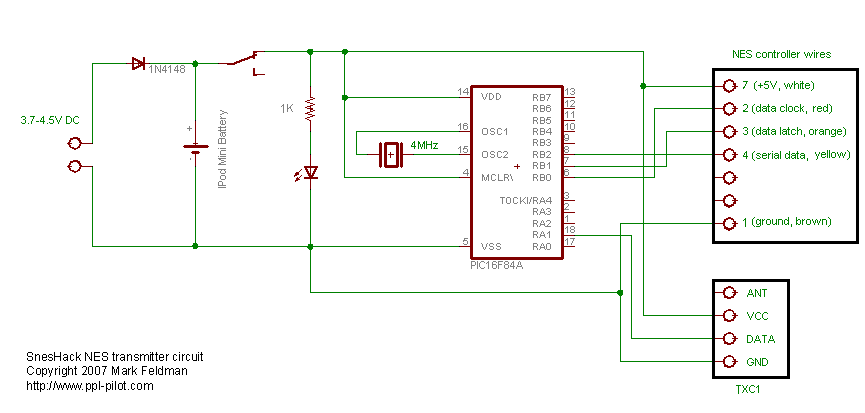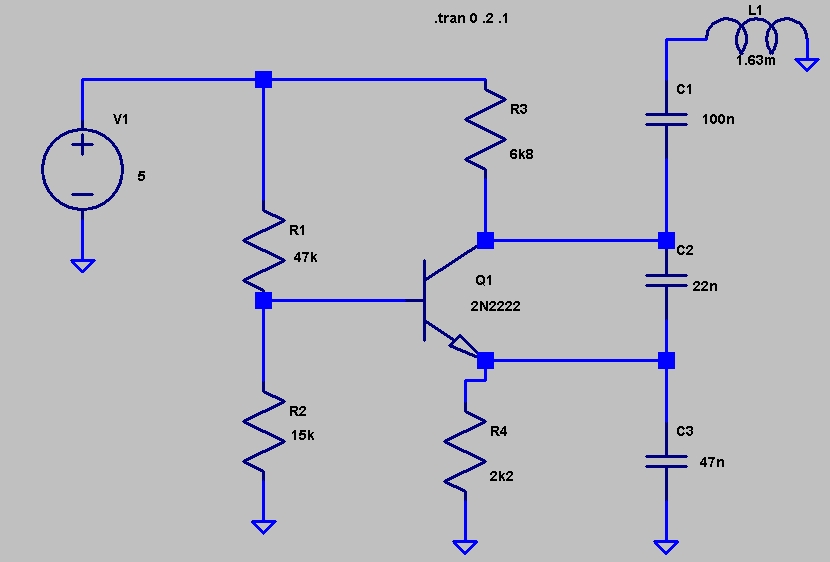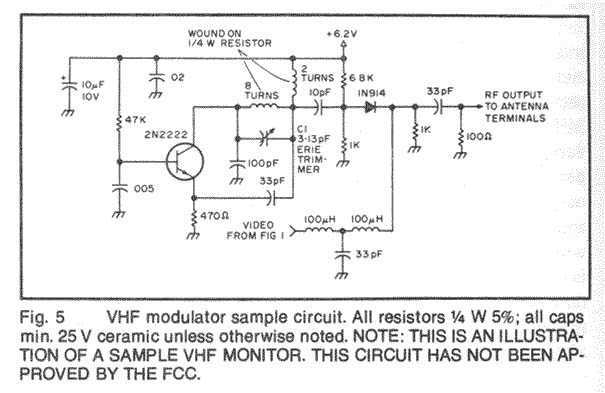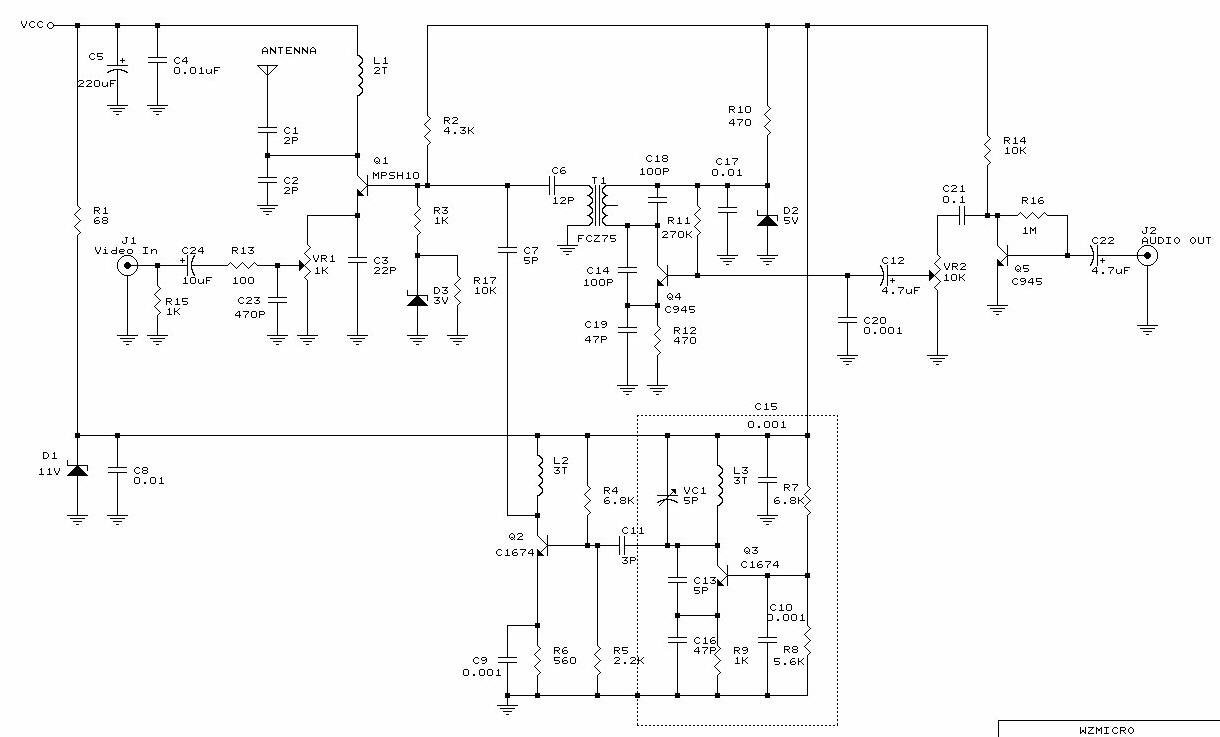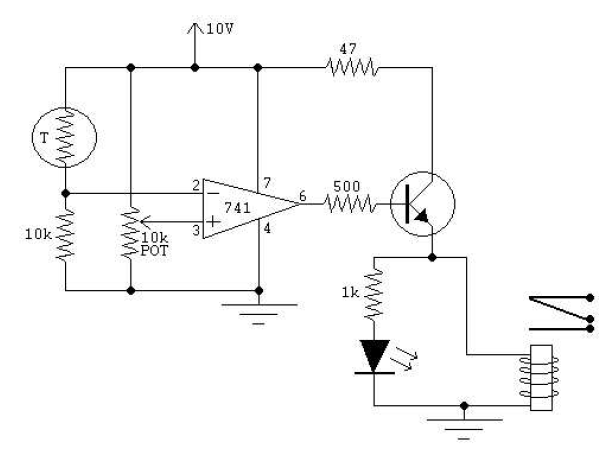
Wireless controlled Door-bell
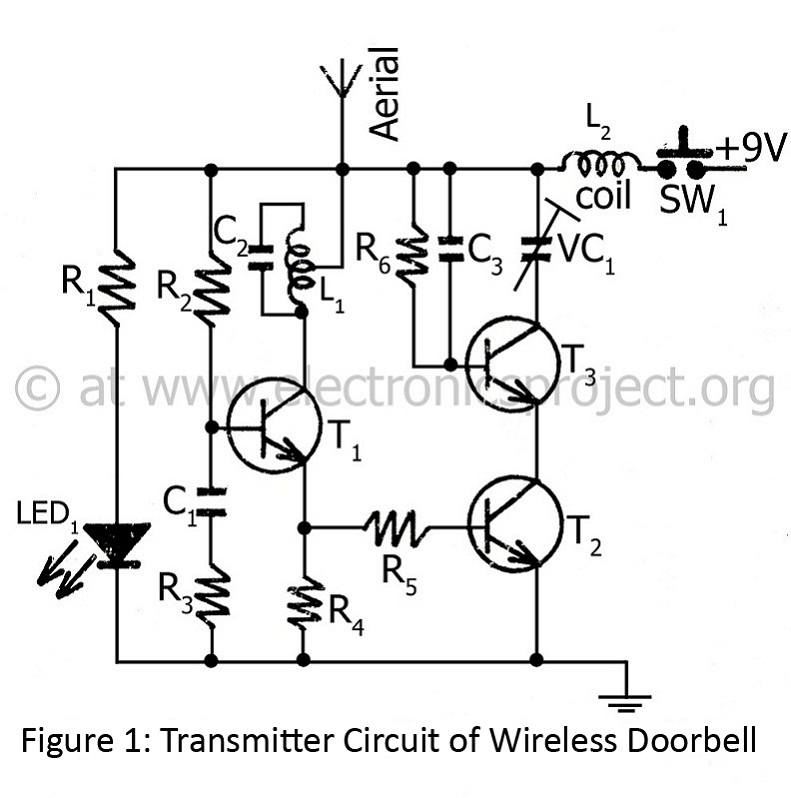
The controlling range of the wireless doorbell is 100 meters. The transmitter section is designed around an oscillator transistor (BF194B) T2, which is followed by two transistors (BC148) T1 and T3. Transistor T2 generates a specific radio frequency determined by a trimmer (variable capacitor) and a coil. Transistor T1 functions as a pulse generator. The output from transistor T3 is fed to the emitter of transistor T2 to obtain the radio frequency from its collector. Trimmer VC1 is used to adjust the transmitter frequency. An aerial is employed to receive the transmitted frequency from the remote unit, which is subsequently amplified by an amplifier and trigger circuit. The entire receiver circuit utilizes seven transistors. Transistor T4 receives the frequency from the hand unit and sends it to a tuned circuit made from capacitor C6 and coil L2. Transistor T5 acts as a comparator, sending amplified voltage to capacitor C11 for filtering. The filtered voltage is passed through a detector stage, rectified, and applied to the base of transistor T6. Transistor T6 is configured in amplifier mode to amplify the signal voltage. The amplified voltage from transistor T6 is then provided to the base of transistor T7, which operates in complementary mode. The positive voltage at the collector of transistor T7 allows transistor T8 to conduct while keeping transistor T9 in a non-conducting state. The positive voltage available at the collector of T9 is supplied to the base of transistor T10. Transistor T10 operates in blocking oscillator mode, producing a bird sound in conjunction with an output transformer.
The wireless doorbell circuit operates efficiently within a range of 100 meters, making it suitable for various residential applications. The transmitter section, centered around the BF194B transistor, is capable of generating a radio frequency that can be finely tuned using a variable capacitor and a coil. This tuning capability ensures optimal performance and reliable signal transmission.
The pulse generation is handled by transistor T1, which creates the necessary pulse signals that modulate the carrier frequency produced by T2. The output from T3, acting as a buffer, provides a stable signal to T2's emitter, facilitating effective frequency generation. The use of trimmer VC1 allows for precise frequency adjustments, ensuring that the transmitter can operate without interference from other devices.
The receiver circuit, composed of seven transistors, is designed to capture the transmitted signal efficiently. Transistor T4 plays a crucial role in receiving the frequency from the hand unit and directing it to the tuned circuit, which consists of capacitor C6 and coil L2. This tuned circuit is essential for filtering out unwanted frequencies and ensuring that only the intended signal is processed.
Transistor T5 functions as a comparator, amplifying the received signal and coupling it to capacitor C11 for filtering. The filtered signal is then rectified in the detector stage, which prepares it for amplification. Transistor T6 amplifies the rectified signal, providing a stronger output that is necessary for driving subsequent stages.
The signal is then sent to transistor T7, which operates in complementary mode to control the conduction of transistors T8 and T9. The interaction between these transistors allows for the modulation of the output signal, ultimately enabling the sound generation through transistor T10. The blocking oscillator configuration of T10 is particularly effective for producing the desired bird sound, which is further enhanced by the output transformer.
Overall, this wireless doorbell circuit exemplifies a well-designed system that integrates various electronic components to achieve reliable performance and sound generation. The careful selection and arrangement of transistors, along with tuning and filtering stages, contribute to the efficiency and effectiveness of the device.The controlling range of wireless doorbell is 100M. Transmitter:- This transmitter section is designed around oscillator transistor (BF194B) T2 followed by two transistor (BC148) T1 and T3. Transistor T2 generate special radio frequency determined by trimmer (variable capacitor) and coil. Transistor T1 is used as pulse generator. The output from transistor T3 is given to emitter of transistor T2 in order to get radio frequency from its collector. Trimmer VC1 is used to adjust the transmitter frequency. An aerial is used to receive the transmitted frequency from remote which is further amplified by amplifier and trigger circuit. The whole receiver circuit utilizes seven transistors. Transistor T4 get frequency from hand unit and further send to tuned circuit made from capacitor C6 and coil L2.
Transistor T5 is used as comparator which further send amplify voltage to capacitor C11 for filter. The filter voltage is passed through detector stage i. e. rectify and given to base of transistor T6. Transistor T6 is adjusted in amplifier mode for amplifying the signal voltage. The amplified voltage from transistor T6 is given to base of transistor T7, used in complementary mode. The positive voltage at collector of transistor T7 let transistor T8 in conducting state and T9 in non- conducting state.
The positive voltage available at collector of T9 is given to base of transistor T10. Transistor T10 is used here in blocking oscillator mode which further produces bird sound combining with output transformer. 🔗 External reference
The wireless doorbell circuit operates efficiently within a range of 100 meters, making it suitable for various residential applications. The transmitter section, centered around the BF194B transistor, is capable of generating a radio frequency that can be finely tuned using a variable capacitor and a coil. This tuning capability ensures optimal performance and reliable signal transmission.
The pulse generation is handled by transistor T1, which creates the necessary pulse signals that modulate the carrier frequency produced by T2. The output from T3, acting as a buffer, provides a stable signal to T2's emitter, facilitating effective frequency generation. The use of trimmer VC1 allows for precise frequency adjustments, ensuring that the transmitter can operate without interference from other devices.
The receiver circuit, composed of seven transistors, is designed to capture the transmitted signal efficiently. Transistor T4 plays a crucial role in receiving the frequency from the hand unit and directing it to the tuned circuit, which consists of capacitor C6 and coil L2. This tuned circuit is essential for filtering out unwanted frequencies and ensuring that only the intended signal is processed.
Transistor T5 functions as a comparator, amplifying the received signal and coupling it to capacitor C11 for filtering. The filtered signal is then rectified in the detector stage, which prepares it for amplification. Transistor T6 amplifies the rectified signal, providing a stronger output that is necessary for driving subsequent stages.
The signal is then sent to transistor T7, which operates in complementary mode to control the conduction of transistors T8 and T9. The interaction between these transistors allows for the modulation of the output signal, ultimately enabling the sound generation through transistor T10. The blocking oscillator configuration of T10 is particularly effective for producing the desired bird sound, which is further enhanced by the output transformer.
Overall, this wireless doorbell circuit exemplifies a well-designed system that integrates various electronic components to achieve reliable performance and sound generation. The careful selection and arrangement of transistors, along with tuning and filtering stages, contribute to the efficiency and effectiveness of the device.The controlling range of wireless doorbell is 100M. Transmitter:- This transmitter section is designed around oscillator transistor (BF194B) T2 followed by two transistor (BC148) T1 and T3. Transistor T2 generate special radio frequency determined by trimmer (variable capacitor) and coil. Transistor T1 is used as pulse generator. The output from transistor T3 is given to emitter of transistor T2 in order to get radio frequency from its collector. Trimmer VC1 is used to adjust the transmitter frequency. An aerial is used to receive the transmitted frequency from remote which is further amplified by amplifier and trigger circuit. The whole receiver circuit utilizes seven transistors. Transistor T4 get frequency from hand unit and further send to tuned circuit made from capacitor C6 and coil L2.
Transistor T5 is used as comparator which further send amplify voltage to capacitor C11 for filter. The filter voltage is passed through detector stage i. e. rectify and given to base of transistor T6. Transistor T6 is adjusted in amplifier mode for amplifying the signal voltage. The amplified voltage from transistor T6 is given to base of transistor T7, used in complementary mode. The positive voltage at collector of transistor T7 let transistor T8 in conducting state and T9 in non- conducting state.
The positive voltage available at collector of T9 is given to base of transistor T10. Transistor T10 is used here in blocking oscillator mode which further produces bird sound combining with output transformer. 🔗 External reference
